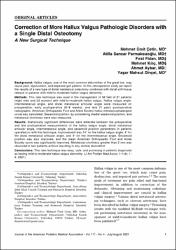| dc.contributor.author | Çetin, Mehmet Ümit | |
| dc.contributor.author | Parmaksızoğlu, A.S. | |
| dc.contributor.author | Fidan, F. | |
| dc.contributor.author | Kılıç, M. | |
| dc.contributor.author | Aybar, A. | |
| dc.contributor.author | Dinçel, Y.M. | |
| dc.date.accessioned | 2022-05-11T14:36:16Z | |
| dc.date.available | 2022-05-11T14:36:16Z | |
| dc.date.issued | 2021 | |
| dc.identifier.issn | 8750-7315 | |
| dc.identifier.uri | https://doi.org/10.7547/18-147 | |
| dc.identifier.uri | https://hdl.handle.net/20.500.11776/8425 | |
| dc.description.abstract | Background: Hallux valgus, one of the most common deformities of the great toe, may cause pain, dysfunction, and impaired gait pattern. In this retrospective study we report the results of a new type of distal metatarsal osteotomy combined with distal soft-tissue release in patients with mild-to-moderate hallux valgus deformity. Methods: This new technique was used in the management of 32 feet of 31 patients (eight men and 23 women) with mild-to-moderate hallux valgus. Hallux valgus angle, i ntermetatarsal angl e, and distal metatarsal articular angl e were measured on preoperative, earl y postoperative (6–8 weeks), and l ate (1 year) postoperative radiographs. American Orthopaedic Foot and Ankle Society hallux metatarsophalangeal score was calculated. Sesamoid position, by considering medial sesamoid position, and metatarsal shortness were also measured. Results: Statistically significant differences were detected between the preoperative and late postoperative measurements of the hallux valgus angle, distal metatarsal articular angle, intermetatarsal angle, and sesamoid position parameters in patients operated on with this technique. Improvement was 14° for the hallux valgus angle, 4° for the distal metatarsal articular angle, and 4° for the intermetatarsal angle. Sesamoid position was also improved, and the mean American Orthopaedic Foot and Ankle Society score was significantly improved. Metatarsal shortness greater than 2 mm was observed in two patients without resulting in any clinical discomfort. Conclusions: This new technique was easy, safe, and promising in patients diagnosed as having mild-to-moderate hallux valgus deformity. © 2021, American Podiatric Medical Association. All rights reserved. | en_US |
| dc.language.iso | eng | en_US |
| dc.publisher | American Podiatric Medical Association | en_US |
| dc.identifier.doi | 10.7547/18-147 | |
| dc.rights | info:eu-repo/semantics/openAccess | en_US |
| dc.subject | diagnostic imaging | en_US |
| dc.subject | female | en_US |
| dc.subject | hallux valgus | en_US |
| dc.subject | human | en_US |
| dc.subject | male | en_US |
| dc.subject | metatarsal bone | en_US |
| dc.subject | osteotomy | en_US |
| dc.subject | retrospective study | en_US |
| dc.subject | treatment outcome | en_US |
| dc.subject | Female | en_US |
| dc.subject | Hallux Valgus | en_US |
| dc.subject | Humans | en_US |
| dc.subject | Male | en_US |
| dc.subject | Metatarsal Bones | en_US |
| dc.subject | Osteotomy | en_US |
| dc.subject | Retrospective Studies | en_US |
| dc.subject | Treatment Outcome | en_US |
| dc.title | Correction of more hallux valgus pathologic disorders with a single distal osteotomy a new surgical technique | en_US |
| dc.type | article | en_US |
| dc.relation.ispartof | Journal of the American Podiatric Medical Association | en_US |
| dc.department | Fakülteler, Tıp Fakültesi, Cerrahi Tıp Bilimleri Bölümü, Ortopedi ve Travmatoloji Ana Bilim Dalı | en_US |
| dc.identifier.volume | 111 | en_US |
| dc.identifier.issue | 4 | en_US |
| dc.institutionauthor | Çetin, Mehmet Ümit | |
| dc.relation.publicationcategory | Makale - Uluslararası Hakemli Dergi - Kurum Öğretim Elemanı | en_US |
| dc.authorscopusid | 57208565301 | |
| dc.authorscopusid | 25723691600 | |
| dc.authorscopusid | 57208564762 | |
| dc.authorscopusid | 57201791012 | |
| dc.authorscopusid | 57195558947 | |
| dc.authorscopusid | 55994580900 | |
| dc.identifier.scopus | 2-s2.0-85115167132 | en_US |
| dc.identifier.pmid | 34478540 | en_US |



















